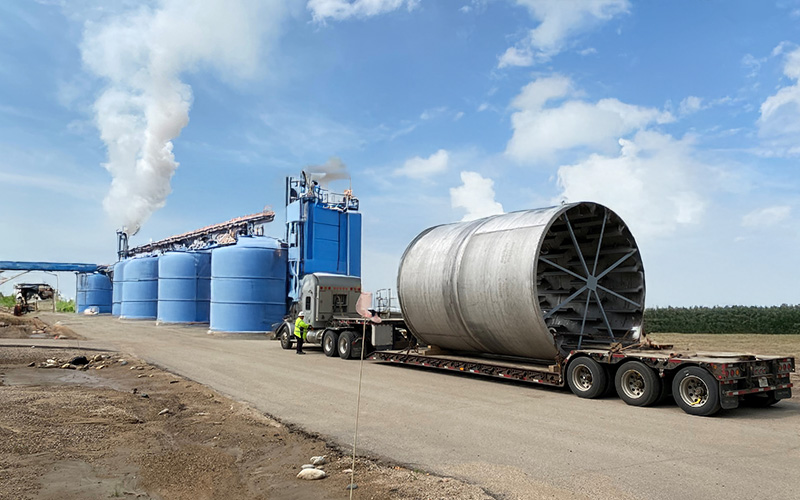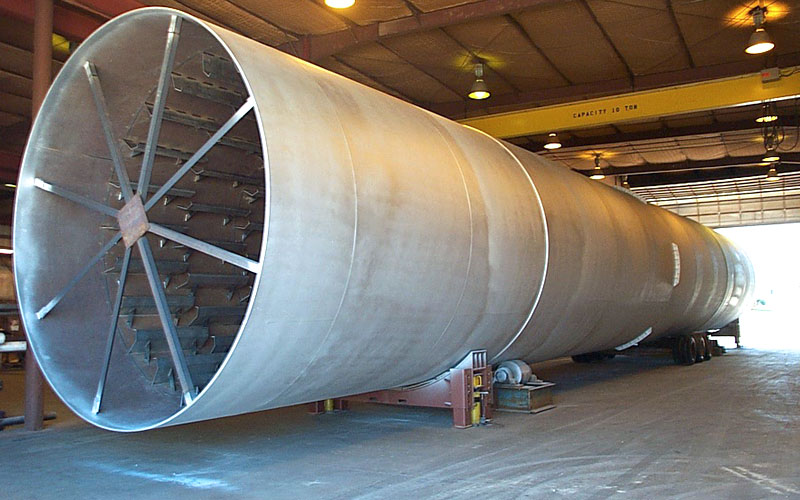Rotary drum shells form the basis of applications ranging from dryers, kilns, and coolers, to agglomerators, coating drums, and more. As one of the primary and most costly components of the equipment, maintaining the integrity of the shell through regular monitoring and repair is critical to maximizing equipment service life and avoiding unnecessary downtime and repairs.
While maintaining shell integrity usually centers around monitoring for abrasion or corrosion, natural wear and tear, poor maintenance practices, challenging materials, inadequate design, and improper operation can also contribute to drum shell health.
Drum shell issues must be addressed as quickly as possible to avoid compromising the structural integrity of the unit. Thus, when cracks, warping, or thinning develop, maintenance teams must carefully evaluate repair options to balance cost, downtime, and long-term performance.
Three primary approaches to drum shell repair exist: minor repairs (ex., patches and welds), section replacement, and full shell replacement. The most appropriate choice, however, is not always clear. As a leading rotary drum service provider, FEECO can evaluate your drum shell and determine the most effective and efficient path to resolution.
Recognizing Rotary Drum Shell Issues
Before shell issues can be resolved, they must first be identified. And while some issues are obvious, others are more subtle, requiring operators and maintenance personnel to carefully monitor the drum’s condition on a regular basis as part of a preventive maintenance program.
What are the Signs of Rotary Drum Shell Issues?
Signs of potential problems with the drum shell may be indicated by:
- Refractory failure in kilns (resulting from excessive ovality/flexing of the shell)
- Minor to moderate visible cracks
- Material leakage from the shell (thin spots or holes)
- “Coke bottle” appearance, in which the shell appears to have expanded around the tires
- Deformation or sagging of the shell
- Hot spots along the drum’s shell
If any of these issues are present, plant managers should call in the original equipment manufacturer (OEM) or other qualified service provider to assess the shell’s condition as soon as possible.
Options in Drum Shell Repair
Depending on the type and severity of wear, one or more options may be appropriate:
Minor Repairs
Localized issues such as fine cracks or stress points are typically minor and easily resolved. Depending on the type and extent of wear, repair may involve welding or patching (or sometimes both) or the use of a wrapper band.
Small cracks or superficial damage can be ground out and filled in with weld to reseal the shell. Where damage is deeper or a localized thin spot exists, a steel patch can be welded on to restore wall integrity and prevent further damage.
When appropriate for the level of wear, welding and patching can provide a quick, cost-effective approach to repair with minimal downtime. For more extensive damage, wrapper bands offer a temporary fix until a new shell or shell section can be manufactured.

Wrapper band installation on a rotary drum in progress
Cautionary Notes in Repairing Drum Shells With Welds and Patches:
Even if shell damage appears to be minimal, an expert should still evaluate the drum’s condition to ensure there is not a larger underlying issue. If hidden issues exist and are unaddressed, repairs will quickly be compromised and wear will worsen.
Additionally, while patches are a cost-effective way to restore shell integrity, they should be used with caution; overuse of patches can cause uneven weight distribution, as well as new stress points.
Shell Section Replacement
Where damage is more widespread or extensive, minor repairs may be insufficient. When this occurs, a shell section replacement is typically necessary. Circumferential cracks, widespread corrosion, or steel patches that can no longer provide sufficient reinforcement demand section replacement.
Section replacement is a significant repair, in which the damaged section must be cut away and replaced with a new section. This requires engineering and manufacturing a new “can” section to match the existing shell.
When the new section is available, the drum will need to be lifted and supported at multiple points to allow for removal of the old section and welding in of the new. This is an in-depth process that must be done with care to ensure the overall structural integrity of the shell. Because the shell has been moved, section replacement must be followed by alignment of the drum for optimal mechanical stability.

Replacement drum shell section
Full Shell Replacement
When the drum is no longer structurally sound and damage is comprehensive, a full shell replacement is required. In this case a complete new shell is fabricated and fitted to the existing drive assembly and base. For this reason, the remaining system components – drive assembly, breechings, etc., must be in good condition or will also likely merit replacement.
If the existing tires will be reused, these will need to be remounted. Additional components that will be reused will also require refitting. This might include breechings, seals, trunnion wheels, thrust rollers, and drive assembly components.
Full shell replacement provides a permanent resolution to shell issues, essentially resetting the life of the unit. As with section replacement, complete shell replacement is an extensive overhaul requiring the old shell to be removed and the new one installed and properly aligned.
While full shell replacement is an extensive undertaking, it also creates an opportunity to improve upon the original design and construction. This might include choosing a different steel grade, increasing shell thickness, or other modifications that help to improve longevity.

Replacement rotary drum shell (with flights) in fabrication
Considerations in Partial vs. Full Shell Replacement
When considering section replacement, plant managers should also weigh the following factors to determine if partial or full shell replacement is most efficient.
Costs to Consider
Although full shell replacement is typically the most costly option, it may prove to be the better approach in some cases, even when section replacement would be sufficient. This is due to the number of field welds required.
A small “can” section of the drum shell may cost significantly less than an entirely new shell, but depending on where the damaged section lies, the cost of multiple field welds may justify the replacement of a larger section (to mitigate the additional weld), or total shell replacement.
Field welding shell sections together is a time-consuming process that must be conducted with expertise to ensure structural integrity. As such, if the section to be replaced lies in the middle of the drum, it may be worth it to instead replace one half of the drum, to avoid requiring two field welds.
Other factors play into this decision as well, including the age and condition of the remaining drum shell, as well as the condition of the internals and the drum’s accessibility.
Similarly, while patches may be less costly upfront, repeated repairs and downtime can make section or full replacements more economical in the long run.
Cause of Failure
Conduct a root-cause analysis to establish any underlying causes of accelerated wear or damage. This may inform on revisions to the replacement design and point to maintenance or operational practices that need to be improved upon or changed.
Oftentimes, shell issues result from poorly chosen materials of construction or shells not built according to the level of required duty.
Which Type of Repair is Best for My Rotary Drum?
The best approach to repair is largely dependent on the type and extent of the issue; small, localized spots can typically be addressed with repair welds or patches, while more widespread damage will require more substantial repairs.
Have the OEM or a qualified service provider conduct a mechanical audit on the unit to evaluate the best option for your specific scenario.
The following table summarizes options and considerations in shell repair:
| When it’s an Option | Advantages | Disadvantages | |
| Minor Repairs (Patches & Welds) | Localized wear such as cracks or superficial damage | Minimal downtime
Low cost Quick repair | Risk of not addressing underlying issues
Overuse of patches can cause problems Repeat costs |
| Section Replacement | Localized thinning or corrosion
Circumferential cracks Patches no longer sufficient | Restores structural integrity without total replacement
Longer-term fix compared to patches | More costly than minor repairs
Requires new shell section (more costly and comes with a lead time to manufacture) Longer downtime than small repairs Requires expertise to install properly Higher cost depending on # of field welds |
| Full Shell Replacement | Shell is no longer structurally sound
Shell exhibits widespread damage Shell is approaching end of life | Resets drum service life
Provides a permanent, lasting solution Opportunity to upgrade design and fabrication | Typically most costly option
Longest lead time Highest downtime for installation Only justified if the remainder of the system is in good condition (vs. total system replacement) |
Tips for Extending Shell Health
As a significant portion of the overall system, drum shell integrity should always be a priority. Fortunately, there are several ways to identify and circumvent potential issues early:
Conduct Regular Monitoring & Inspections
Maintenance and operating personnel should regularly inspect the drum as part of a preventive maintenance program. This should include predefined inspection points at daily, weekly, monthly, and as-needed intervals. When it comes to shell condition, personnel should:
- Look for visual or auditory abnormalities
- Regularly inspect the drum interior as production schedule allows
- Check for improper fitting at breechings
- Follow recommended operating and maintenance procedures
- Run a temperature gun along the combustion chamber or length of the shell or use thermal imaging technology (such as an infrared gun) to check for hot spots on hot kilns.
- Watch for signs of refractory failure, where applicable

Using a temperature gun to check shell temperature
Opt for an Annual Inspection
While routine monitoring by on-site personnel may seem sufficient, having the OEM or other qualified service provider conduct an annual inspection of the drum can be invaluable.
Annual inspections provide a thorough evaluation of the drum’s mechanical condition and any potential issues.
During an annual inspection, FEECO Customer Service Engineers measure and observe various parameters of shell condition to identify issues early. This includes measuring shell thickness to reveal the onset of unseen thin spots.

Rotary dryer annual inspection
Train On-Site Personnel
The value of properly training operators and maintenance personnel cannot be understated. Practices such as excessive cycling or not rotating the shell while the burner remains in operation, can quickly translate to significant shell damage.
Likewise, maintenance personnel must be able to recognize signs of trouble early, know how to address them, and know when to call in the OEM for large-scale repairs.
Conclusion
When drum shell issues arise, plant managers are faced with a spectrum of repair options, from quick welds and patches to full shell replacements. The decision should be guided not just by immediate cost, but also by the overall condition of the drum, the root cause(s) of the damage, and the long-term operational goals of the facility. By carefully weighing these factors, plants can select the right path forward to maximize equipment reliability, minimize downtime, and ensure safe, efficient operation.
FEECO has been manufacturing, inspecting, and servicing rotary drums since 1951. If you suspect your rotary drum may be experiencing shell issues or other problems, contact us today!

